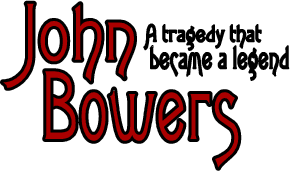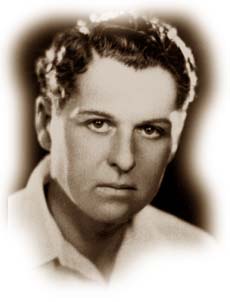 |
 |
 |
 |
Although it has never been officially recognized, it has long been accepted that the Norman Maine character in the 1937 film "A Star is Born" was based on the life of John Bowers. Certainly the plot of "A Star is Born" is filled with incidents that parallel the life and death of Bowers.
John E. Bowersox was born in Garrett, Indiana, on December 25, 1885. Most reports list him as being born in 1899, but the birth records in DeKalb County, Indiana, show John E. Bowersox being born 14 years earlier than most published accounts indicate. His father, George A. Bowersox, was a railroad engineer who moved to Indiana from Ohio. His mother, Ida Bowersox, was born in Maryland. After spending his boyhood in Garrett, he went to Huntington, Indiana, to attend Huntington Business College. While in Huntington, he became interested in the theatre and began to participate in amateur theatricals in the town. He decided to forego a business career for a life on the stage and left Huntington to join a stock company. He slowly gained experience and finally advanced to playing the lead in "The Student Prince."
He began his career in films in an uncredited
role in the 1914 Tom Mix film, "In the Days of the Thundering
Herd." This date lends credence to the fact he was born in
1885. If he had been born in 1899, he would have been only 15
years old at this time. Within two years he had dropped the "ox"
from his name and was the love interest opposite Mary Pickford
as  Allan Walton, "the handsome boarder,"
in the 1916 film "Hulda of Holland." His good looks
and easy manner made him an established leading man by the early
20's. He regularly played opposite some of Hollywood's major female
stars. His most frequent co-stars were Pauline Frederick, Mary
Miles Minter and his future wife, Marguerite De La Motte.
Allan Walton, "the handsome boarder,"
in the 1916 film "Hulda of Holland." His good looks
and easy manner made him an established leading man by the early
20's. He regularly played opposite some of Hollywood's major female
stars. His most frequent co-stars were Pauline Frederick, Mary
Miles Minter and his future wife, Marguerite De La Motte.
He was extremely busy in the late teens and early twenties. He made 11 feature films in 1918 and a total of 34 films from 1919 to 1923. In 1919 Samuel Goldwyn announced a formation within Goldwyn Pictures of a separate unit, Eminent Authors, Inc. He hired a stable of prominent writers including Rex Beach, Mary Roberts Rinehart and Gertrude Atherton. One of the first pictures for this new unit was "Out of the Storm," based on Atherton's novel, "The Tower of Ivory." Bowers played the leading man, John Ordham. In 1922 he was the title character in "Quincy Adams Sawyer." This film had an all-star cast which featured three other Hoosiers: Louise Fazenda, Elmo Lincoln, and Victor Potel.
He was first cast opposite Marguerite De La Motte in a film called "Desire" in 1923. Their relationship caused sparks both on and off the screen. They were a popular movie couple, appearing together in no less than twelve films from 1923 to 1927. They were married shortly after their first film together.
Although he made seven features in 1927, the year sound was introduced, Hollywood's transition to the talkies nearly ended his career. He appeared in just three sound films. In the 1929 film, "Say it with Songs," he played a "handsome surgeon" who saves the life of child star Davey Lee, thereby enabling Al Jolson to get back together with his wife. In 1929 he had a minor role in "Skin Deep" which starred fellow Hoosier Monte Blue and was directed by another Hoosier, Ray Enright. His last sound film was "Mounted Fury" (1931), a Western in which he played an alcoholic. Bowers by this time was well on his way toward becoming an alcoholic in real life. By 1932 he was a has-been. There were no acting jobs for him. His wife divorced him.
In 1934 he returned to Indiana to take care of his ailing mother who was living in Syracuse. She died in 1936. Bowers returned to Hollywood, depressed and broke. He went to Catalina Island where he heard his old friend Henry Hathaway was directing a picture. Hathaway recalled that Bowers came to him and said, "I've got to have a job." Hathaway explained the company was shooting only exteriors on the island and using few actors. Then Bowers asked for a major role. "I know I could handle it," he pleaded. Hathaway told him to telephone the studio after he returned to the mainland. Bowers told him, "This is the last time I'll ask for a job."
Hathaway invited him to have dinner with members of the company and then paid his steamer fare and gave him money for a taxi back to Hollywood. When he left the company, Bowers said, "Well, this is the last time you'll ever see me. You'll have a real life picture. I'm going to jump overboard." The next morning Bowers rented a small sailboat at Santa Monica and went out into the ocean alone. On November 17, 1936, John Bowers' body was washed ashore at Malibu Beach.
On November 18, 1936, Variety's obituary stated, "The body of John Bowers, star of silent pictures, was washed ashore today at Malibu Beach. A deputy sheriff friend identified the body and disclosed that the actor had declared his intention to commit suicide by getting into a boat and 'sailing away into the sunset.' A man resembling Bowers rented a boat Sunday (15). It was found later empty and adrift."
The most widespread report was that he ended his life at age 49 by walking into the Pacific Ocean at Malibu and deliberately drowning. His suicide was reportedly witnessed by writer Adela Rogers St. John, who was an uncredited writer for "A Star is Born" in 1937. Obviously no one could have witnessed Bowers' suicide since he went out in the ocean alone in a boat. St. John mentions nothing about the incident in her autobiography. She wrote the story for "What Price Hollywood?" in 1932 before Bowers' death. It had a similar storyline but did not end with the hero drowning. It is likely that the plotline of "A Star is Born" was a composite of the lives of John Barrymore, John Gilbert and John Bowers. Apparently a suicide by walking into the ocean was considered to be more dramatic than renting a boat and jumping overboard. Remakes of "A Star is Born" in 1954 and 1976 used essentially the same plot.
It is sad to think that today John Bowers is remembered primarily as the inspiration for a plotline that was so fascinating it was used in three films. He was one of the most popular silent leading men of his day, who became an overnight star and then just as quickly faded into obscurity, leading to a premature death.
Bibliography
Books
Marill, Alvin H. "Samuel Goldwyn Presents" A.S. Barnes and Company, 1976
Katz, Ephraim "The Film Encyclopedia" Perigee Books 1979.
Parrish, James Robert "The Hollywood Death Book" Pioneer Books, Inc. 1992.
Newspapers
"Jobless Star of Silent Films is Suicide in West" Anderson (Indiana) Daily Bulletin, November 18, 1936.
"John Bowers Dies" Variety November 18, 1936.
Other
1900 Census, DeKalb County, Indiana, Town of Garrett
Internet Movie Data Base
http://www.imdb.com
Allmovie Guide
http://www.allmovie.com
copyright 2002 by David L. Smith. All rights
reserved.